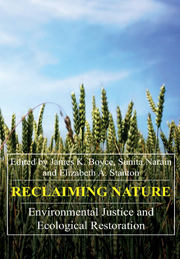Book contents
- Frontmatter
- Contents
- List of Figures and Tables
- Acknowledgements
- Introduction
- Part I ADDING VALUE
- Part II DEMOCRATIZING ACCESS
- 5 Land Reform and Sustainable Development
- 6 Extractive Reserves: Building Natural Assets in the Brazilian Amazon
- 7 Mining Rights and Community Rights: Poverty amidst Wealth
- 8 Natural Assets and Participatory Forest Management in West Africa
- Part III CAPTURING BENEFITS
- Part IV DEFENDING THE COMMONS
- About the Contributors
- Index
7 - Mining Rights and Community Rights: Poverty amidst Wealth
from Part II - DEMOCRATIZING ACCESS
Published online by Cambridge University Press: 05 March 2012
- Frontmatter
- Contents
- List of Figures and Tables
- Acknowledgements
- Introduction
- Part I ADDING VALUE
- Part II DEMOCRATIZING ACCESS
- 5 Land Reform and Sustainable Development
- 6 Extractive Reserves: Building Natural Assets in the Brazilian Amazon
- 7 Mining Rights and Community Rights: Poverty amidst Wealth
- 8 Natural Assets and Participatory Forest Management in West Africa
- Part III CAPTURING BENEFITS
- Part IV DEFENDING THE COMMONS
- About the Contributors
- Index
Summary
Introduction
In the 1990s, the global mining industry experienced unprecedented expansion, establishing a presence in countries with no prior history of commercial mining, particularly, in the global South. Latin America became the world's most important destination for mining-related investment capital. The regions of West Africa and South-east Asia also experienced rapid growth in mining activity (Chalmen 1999, 2000). Expansion was driven by rising mineral prices in response to growing demand, and was also promoted by the policies of the international financial institutions, which favoured privatization and permitted foreign investors to enter economic sectors and exploit natural resources that had previously been inaccessible.
The boom has imposed high environmental and social costs on communities in the global south. In some cases, mining threatens the very survival of local subsistence economies. Consequently, conflict between mining companies and communities has grown in parallel with the industry. This poses enormous challenges for communities, who often lack the skills and tools that are needed to address conflict adequately and constructively.
Communities have begun to develop a number of strategies to secure greater control over mining activity. In some cases, communities seek to impede the development of mining projects in their territories, judging them to be incompatible with local development. In other cases, communities have accepted the presence of mining activity and have attempted to establish a new, more equitable relationship with industry that integrates mining with local strategies for sustainable development.
- Type
- Chapter
- Information
- Reclaiming NatureEnvironmental Justice and Ecological Restoration, pp. 181 - 202Publisher: Anthem PressPrint publication year: 2007



